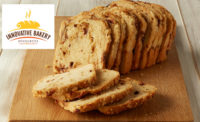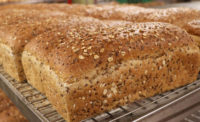New solutions for clean label, healthy breads
Solutions for clean label, nutritional enhancements and extended shelf life help meet prevailing demands.

courtesy of Cargill

courtesy of Cargill

courtesy of Carolina Innovative Food Ingredients

courtesy of Ardent Mills

courtesy of Cargill





Fresh bread, bagels and English muffins comprise the largest segment in bakery, valued at over $10 billion per IRI, Chicago. But sales overall remain relatively flat. Nevertheless, several strategic options exist for bakers to infuse new life into bread sales.
Organic has shown strong growth of late—and really is the original clean label. “Consumers want to see labels with ingredients that they are familiar with, and may even have in their own kitchens,” says Jerome Davis, technical solutions analyst, Innovative Bakery Resources, Tualatin, OR. He suggests many consumers would prefer organic over conventional—when the products are economically comparable.
“We find that organics and artisan-style breads have garnered great interest from the North American market,” says Cam Suárez-Bitár, marketing coordinator, Bellarise, Pasadena, CA. “These changes have been fueled by millennials’ taste for healthy, better-for-you and authentic foods. Considering how millennials’ spending power far outweighs that of previous generations, industry growth could be influenced by how well bakeries respond to such shifts in demand. Further development of artisan-style, shelf-stable breads also presents bakeries with great opportunities entering 2018.”
Consumers want to see natural ingredients and more artisan flavor, says Jeff Nelson, western vice president of sales, Brolite Products, Inc., Streamwood, IL. “We’re moving away from softer white bread and toward the heartier and crunchier-crusted artisan breads. The grainier and more-textured darker breads have gotten popular, too. We’re also seeing more in-store bakeries and ‘bake at home’ breads that give a fresher and more-homemade feel.”
Label scrubbing
“Consumers are looking for shorter ingredient statements made with names they recognize,” says Bill Gilbert, Certified Master Baker, principal food technologist, Cargill, Minneapolis. “The bread industry knows that better than anyone.”
Clean label continues to grow into the mainstream, notes Harold Ward, director of technical service and product applications, Bay State Milling Co., Quincy, MA. “As consumers become more aware and focus on ingredient legends, bakers are looking for ways to produce quality products without the use of many functional ingredients that have been utilized in the past.”
This often stems from a shoppers perception that associates clean label with health and wellness. “The desire for a cleaner label satisfies many consumers’ desire to choose healthier products and can be a major factor influencing a purchase,” says Barry Clayton, senior vice president, bakery ingredients, AB Mauri North America, St. Louis.
Marie Thomas, vice president, innovation, baking ingredients, AB Mauri North America, notes that ingredients on the chopping block include sodium stearoyl lactylate (SSL), diacetyl tartaric acid esters of mono- and diglycerides (DATEM), azodicarbonamide (ADA) and calcium peroxide—but that clean-label conditioning and preservation solutions are available that don’t compromise quality, taste or functionality.
Nelson notes that Brolite offers a clean-label shelf-life extender called BNB Extender. He suggests opting for enzyme-based blends to help reduce complications related to scaling enzymes directly and properly dispersing these micro ingredients throughout large quantities of dough.
“Another extension of the clean-label movement is growing interest in how ingredients are made,” says Gilbert. “It’s that concern that has demand for non-GMO ingredients increasing.” He notes Cargill now offers a wide range of Non-GMO Project Verified ingredients for baking.
Gilbert notes Cargill has invested significant R&D into new clean-label bread solutions. “Two years and hundreds of tests later, we landed on a replacement strategy for the entire dough conditioner package, without adding a single new ingredient to the product label.” The solution features enzymes and lecithin—both ingredients commonly found in bread formulas.
Nutritional, artisan intrigue
“Brands are trying to combat the perception of bread as a purely indulgent product, so products with an infused health element continue to be of interest,” says Paul Verderber, vice president of sales, Carolina Innovative Food Ingredients, Inc., Nashville, NC. “Our sweet potato–based flour, Carolina Craft, is seeing strong interest because it can enhance health-focused products in the retail bread space.” Additionally, he recommends dehydrated sweet potato granules as a topping or inclusion for breads. Sweet potato ingredients offer a strong nutritional profile, including high levels of vitamin A, beta-carotene, potassium, calcium, and soluble and insoluble fiber.
Whole grains and seeds also add unique flavors and textures. “These ingredients can create a more-rustic, artisan aesthetic when used to enrobe breads,” says Davis. “Some of the varieties we have developed contain more inclusions by weight than flour.”
Ward recommends Bay State Milling’s SowNaked high-protein oats and BeneGrain sprouted ingredients, including wheat, rice, millet and quinoa, in artisan and other breads. “Grain blends and seed blends used as a topping or inclusion will enhance flavor and texture, in addition to adding visual interest.”
Fiber also adds significant nutritional clout. Zachery Sanders, marketing director, Ardent Mills, Denver, recommends Sustagrain, an identity-preserved, hull-less barley that delivers three times the fiber of oats and 10 times that of brown rice. “We also offer a number of colored barleys—purple, blue and black—that provide a unique burst of color. Also, our Ultragrain white whole wheat has become the go-to whole-wheat flour in school foodservice and other settings because of its smooth texture, light color, mild flavor and flexibility in recipe development.”
Gilbert suggests more consideration for protein in health-forward breads. “While it can be a challenge to find the right mixture of proteins to deliver a quality bread, we’ve used Cargill’s pea protein products to create a bread with 9 grams of total protein that still meets consumer expectations.”
Also, the baking industry needs to continue to build calcium awareness, notes Matt Patrick, director of research and development, Delavau Food Partners, Philadelphia. “Calcium is essential to build health and strong bones during childhood, but some children don’t like or can’t tolerate milk. Calcium-fortified breads are essential for these families, and it’s easy for bakers to add this vital nutrient to their breads with our calcium-fortification ingredients. We also offer sodium-reduction technology, so brands can achieve lower sodium levels without affecting the taste or texture of the finished product.”
Nelson notes that “exotic” ingredients like quinoa and chia can also boost nutrition—and recommends adding sour notes to breads to elicit strong impact via aroma. “With consumers constantly sharing opinions on social media, being a different, tasty and healthy product can give the product a great reputation, which in turn generates shopper interest.”
Bakeries can command higher prices for breads that have the right mix of characteristics. “Rustic breads that contain a variety of grains and seeds are seeing increased interest,” says Nelson. “Consumers are willing to pay a premium price for these products.”
Abby Ceule, senior industry director, bakery, Corbion, Lenexa, KS, cites company research showing that ingredient-focused and nutrition-focused consumers are willing to pay more for products with 12 or fewer ingredients.
Ceule notes that Corbion has also continued to growth of artisan breads. “Bakers are experimenting with different inclusions and end applications—from ingredients like fruits, nuts and ancient grains to finished products like challah bread and products with sweet and savory flavor combinations.”
Robust, flavorful, complex artisan breads are leading the way with consumers, notes Thomas. She recommends using preferments and cultures—such as the Aromaferm line of cereal ferments—to help accelerate large production runs capable of reaching a wider audience.
Tackling shelf life
Extending the shelf life of breads requires striking a strong balance between old and new techniques. “Optimization of the formula and production process both result in improved shelf life and quality,” says Ward. “Selecting the right ingredients for a specific application and focusing on the basics of fermentation and dough development will pay dividends in finished product quality.”
Verderber notes that clean-label sweet potato flour can help extend shelf life. “Our sweet potato flour has extended shelf life in baked goods an average of three days, in addition to delivering nutritive benefits.”
Patrick notes Delavau Food Partners offers proprietary solutions to extend shelf life. “We can also deliver better surface texture for an improved eating experience, and all with clean labels.”
Packaging can also play a role. “There are existing technologies in packaging that allow products to last for months with no added shelf-life extenders—for example, modified-atmosphere and vacuum packaging,” says Davis. He also points toward clean-label ingredient options that reduce pH and help control microbial growth. “We use stringent environmental and sanitation practices, along with combinations of enzymes, cultured wheat flour and vinegar, to maintain softness and extend shelf life.”
A variety of enzyme solutions on the market help bakers extend shelf life while ensuring product quality, notes Ceule. “At Corbion, we specially designed our Ultra Fresh portfolio to help bakers—from production to consumption—enhance the tolerance, texture and volume of baked goods.”
Sometimes bakeries might need to take the lead on educating consumers on how clean-label, enzyme-based shelf-life extenders and improvement systems work, suggests Suárez-Bitár. “When we develop ingredients, we look beyond a past when breads featured chemicals and other impurities that have absolutely nothing to do with real baking. Our enzyme-based softeners eliminate the need for any chemicals in today’s breads, so that tomorrow’s consumers can enjoy top-quality, real baked goods that also present a great value.”
Bread has a distinct opportunity to emerge as a nutrition leader in bakery today. “As an industry,” says Clayton, “we need both bakers and ingredient suppliers to be working more closely with nutrition experts so we can be ahead of the curve to incorporate real benefits into products that not only appeal to our palates, but also provide additional health benefits.”
Looking for a reprint of this article?
From high-res PDFs to custom plaques, order your copy today!












